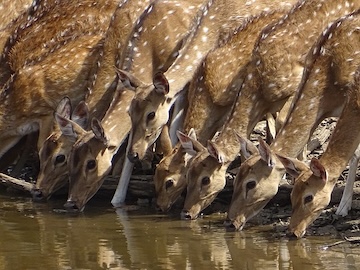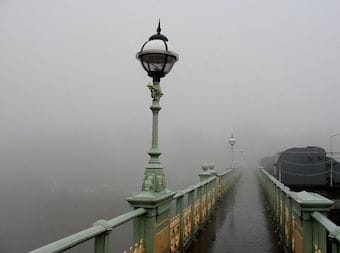An Indian grey mongoose (Herpestes edwardsi) in Amravati in northern Maharashtra, about 90 miles west of Nagpur. Kipling tells us that the English couple lived in a bungalow in Sugauli, a town in the modern-day State of Bihar near the border with Nepal. Bungalows were typical of the houses built for colonial settlers in Bengal, and indeed ‘bungalow’ is derived from the Gujarati word bangalo, meaning ‘Bengal-style’. Some were ‘dak bungalows’ made for postal workers, criticised by Kipling’s father for being as plain as a haystack and hardly more luxurious. Others could be quite grand, extending to more than one floor, embellished with verandahs and surrounded by that most English of domestic requirements, a garden.
“WHO is Nag?” said he. “I am Nag. The great God Brahm put his mark upon all our people, when the first cobra spread his hood to keep the sun off Brahm as he slept.* Look, and be afraid!”
He spread out his hood more than ever, and Rikki-tikki saw the spectacle-mark on the back of it that looks exactly like the eye part of a hook-and-eye fastening.* He was afraid for the minute, but it is impossible for a mongoose to stay frightened for any length of time, and though Rikki-tikki had never met a live cobra before, his mother had fed him on dead ones, and he knew that all a grown mongoose’s business in life was to fight and eat snakes. Nag knew that too and, at the bottom of his cold heart, he was afraid.
* Brahma is the Hindu creator-god. Kipling here echoes a tale told of the Buddha, Siddhartha Gautama (?5th-4th century BC), which tells how Mucalinda, the great Cobra, sheltered the newly-enlightened Buddha from the blazing sun with his hood. For the tale as retold by English naturalist John George Wood (1827-1889), see How the Cobra Got His Spectacles. According to Sikh lore, a cobra performed the same office for the founder of Sikhism, Guru Nanak (1469-1539). Buddhism also tells another tale, in which the naga Mucalinda sheltered the Buddha from a great storm for seven days.
* For the posterior view of the cobra’s hood, see a photo at ‘Indian cobra’ (Wikimedia Commons). For the clasp, see ‘Hook-and-eye clasp’ (Wikimedia Commons).
Questions for Critics
1. What is the author aiming to achieve in writing this?
2. Note any words, devices or turns of phrase that strike you. How do they help the author communicate his ideas more effectively?
3. What impression does this passage make on you? How might you put that impression into words?
Based on The English Critic (1939) by NL Clay, drawing on The New Criticism: A Lecture Delivered at Columbia University, March 9, 1910, by J. E. Spingarn, Professor of Comparative Literature in Columbia University, USA.
Archive
Word Games
Jigsaws Based on this passage
Express the ideas below in a single sentence, using different words as much as possible. Do not be satisfied with the first answer you think of; think of several, and choose the best.
Spinners Find in Think and Speak
For each group of words, compose a sentence that uses all three. You can use any form of the word: for example, cat → cats, go → went, or quick → quickly, though neigh → neighbour is stretching it a bit.
This exercise uses words found in the accompanying passage.
1 Foot. Know. Wife.
2 I. Live. Spread.
3 Five. He. Length.
Variations: 1. include direct and indirect speech 2. include one or more of these words: although, because, despite, either/or, if, unless, until, when, whether, which, who 3. use negatives (not, isn’t, neither/nor, never, nobody etc.)
Confusables Find in Think and Speak
In each group below, you will find words that are similar to one another, but not exactly the same. Compose your own sentences to bring out the similarities and differences between them, whether in meaning, grammar or use.
This exercise uses words found in the accompanying passage.
High Tiles Find in Think and Speak
Make words (three letters or more) from the seven letters showing below, using any letter once only. Each letter carries a score. What is the highest-scoring word you can make?
Your Words ()
Post Box : Ask Nicholas
Grok : Ask Grok
You are welcome to share your creativity with me, or ask for help with any of the exercises on Clay Lane. Write to me at this address:
See more at Post Box.
If you like what I’m doing here on Clay Lane, from time to time you could buy me a coffee.
Buy Me a Coffee is a crowdfunding website, used by over a million people. It is designed to help content creators like me make a living from their work. ‘Buy Me a Coffee’ prides itself on its security, and there is no need to register.
Related Posts
The animals in the jungle agree that amidst the drought, the sport of hunter and hunted has to be suspended.
Picture: © ArghoRoy118, Wikimedia Commons. CC BY-SA 3.0.. Source.
Posted November 7 2024
If officials in the Raj ever forgot who their boss was, they would bring the whole government down about their ears.
Picture: © Maxwell Hamilton, Wikimedia Commons. Licence: CC BY-SA 2.0 Generic.. Source.
Posted August 4 2020
Picture: © Shobha Elizabeth John, Wikimedia Commons. Licence: CC-BY-SA 4.0.. Source.
Posted December 31 2018






